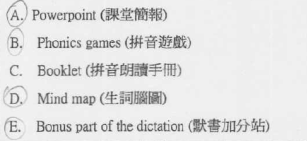The project reported here entailed a cycle of assessment used for learning purposes (rather than to grade students), direct instruction, self-learning, and reflection. The teachers made use of data from assessment tasks for different purposes, viz. identifying and understanding their students' weaknesses, and devising materials for remedial teaching. The design of phonics pre-test and post-test helped the teachers develop targeted phonics materials and track student learning progress.
According to the results of the read-aloud test, the actions implemented had a positive impact on student learning. From an analysis of phonics post-test results, students of both P5 classes were able to make progress in the target skills.

The above table shows that there is a significant drop in the percentage of students in the proficiency categories ‘weak and poor’. The improvement of student performance may also be understood through triangulation of other data, e.g. an end-of-year questionnaire, and student work.
Class 5A (Total no. of students: 27)
The activities gave them opportunities to practise speaking English. The majority of the students (16) felt that they had tried their best to improve their performance. Quite a number of them found that the phonics games and the bonus part of the dictation helped them improve their target skills. This was reflected in the increase in the number of students obtaining higher marks in their post-test in this class (12 students in blends test and 3 students in rimes test).
Class 5B(Total no. of students: 27)
Many of the students (11) felt confident about their learning. Many of them found that the PowerPoint (12), phonic games (10), booklet (6) and the bonus part of the dictation (6) helped them improve their target skills. This was reflected in the increase in the number of students obtaining higher marks in their post-test in this class (13 students in blends test and 15 students in rimes test).
The end-of-year questionnaire (Jun 2011) also gave students an opportunity to describe the strategies they used when preparing for the phonics post-test. This is a sign of progress since they did not write much on this question in the questionnaire completed in the first term.
Question: How did you use the preparation time?
Students also appreciated teachers’ effort to provide various activities for them.

For some students, reading English texts is still a challenging task:
But some began to get interested in reading aloud:
Apart from the good impact on phonic awareness, the teachers pointed out that the project also helped the students enrich their vocabulary. For example, they learned new words when they were looking for words to complete a mind map exercise in their note books.
Students’ positive attitude to learning was also reflected in the effort they put into completing the bonus section of the dictation. They became very serious and eager as they worked hard to get marks on the phonics skills related part. The teachers noted that some students were more willing to apply the phonics knowledge in the oral exam to tackle unfamiliar words. The students were serious and motivated in learning and their vocabulary was enriched as a result of classroom activities.
| 
